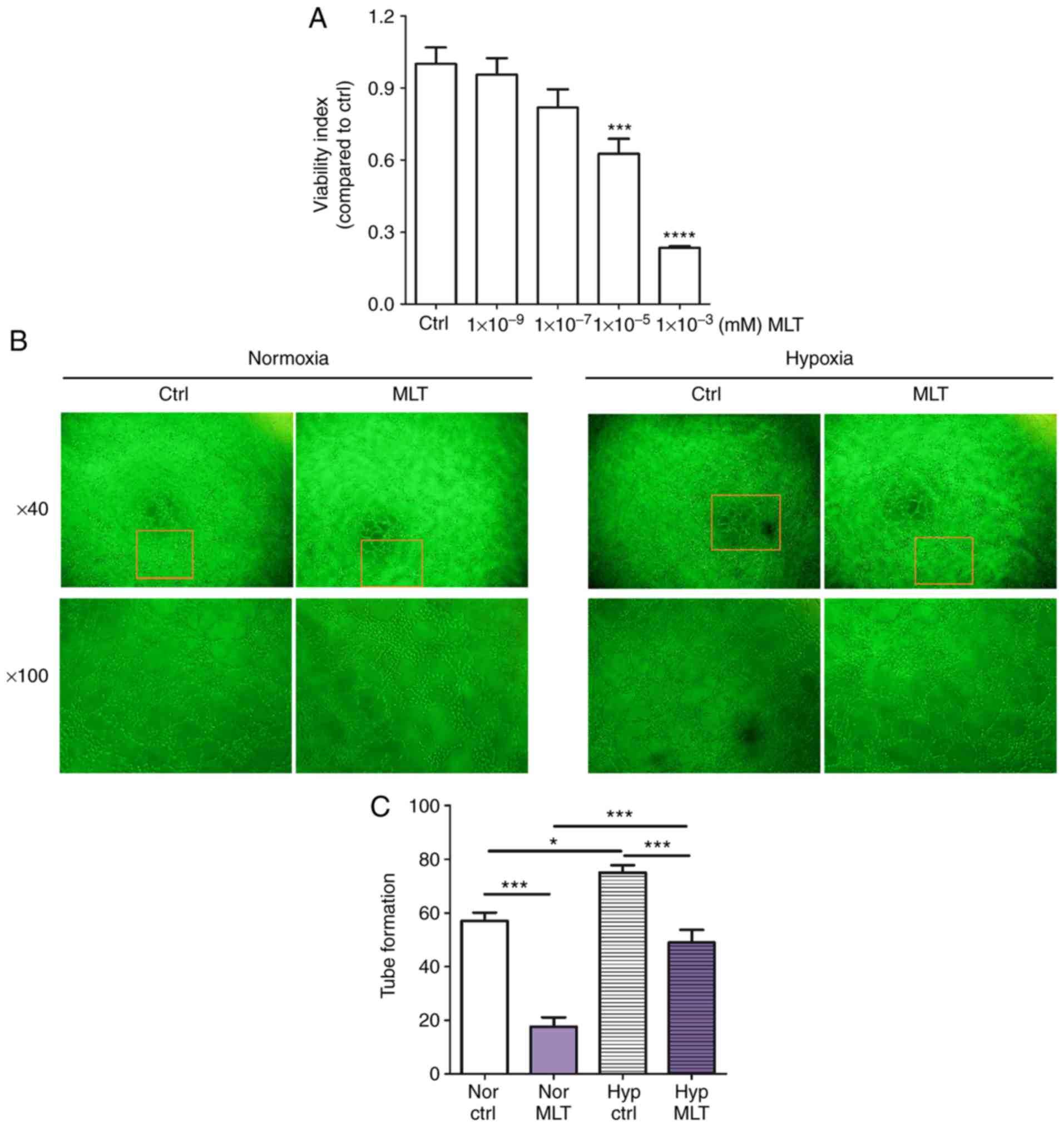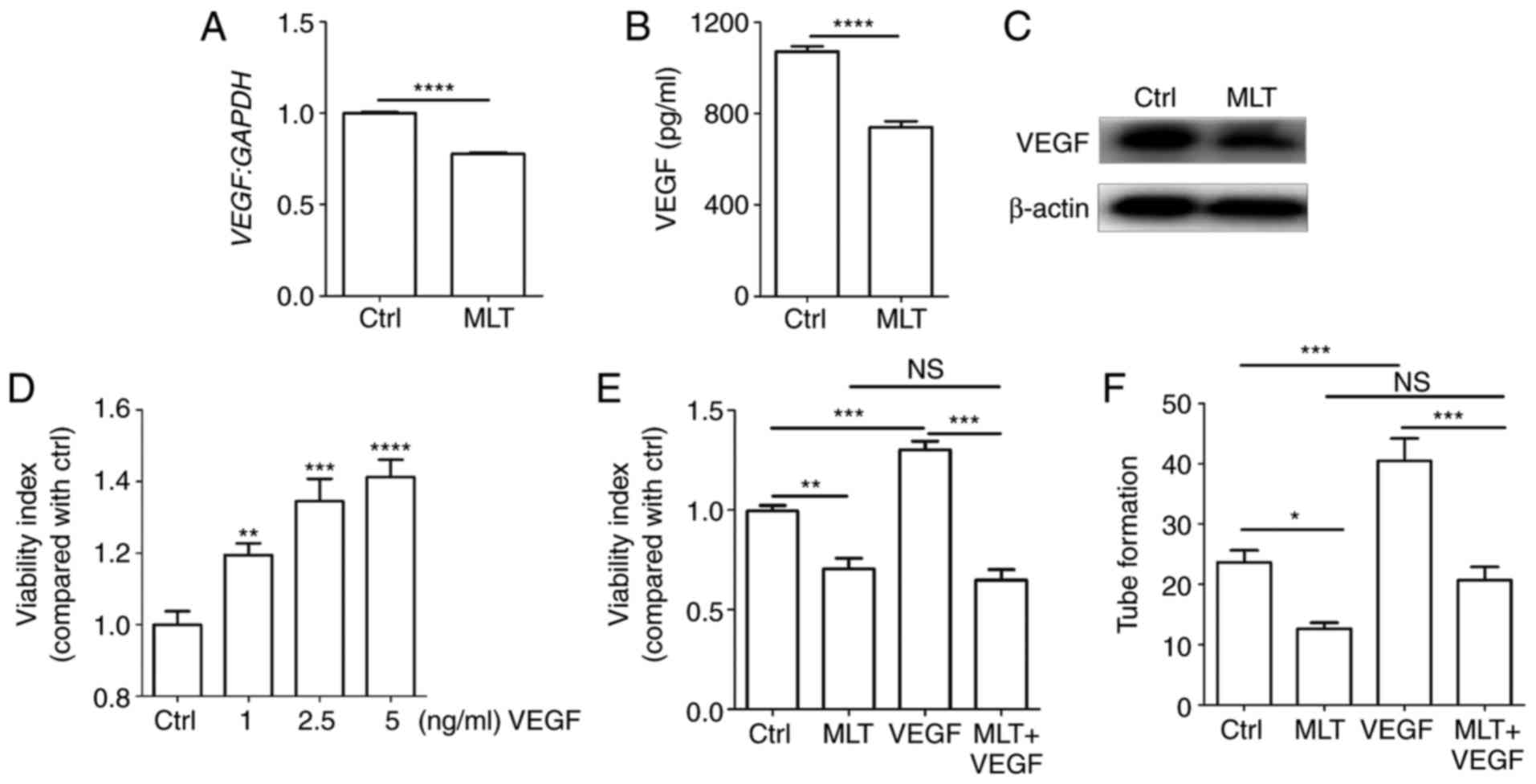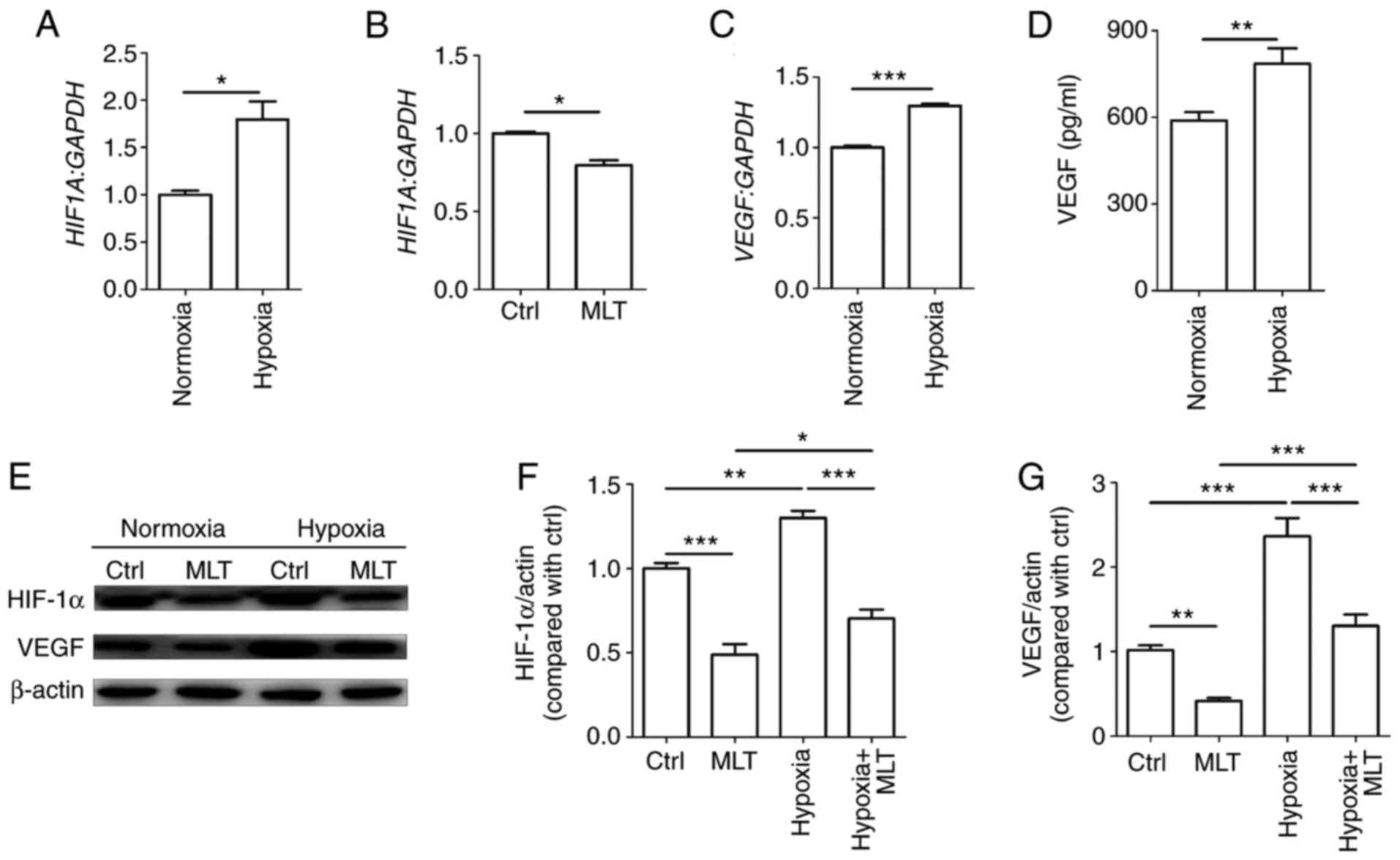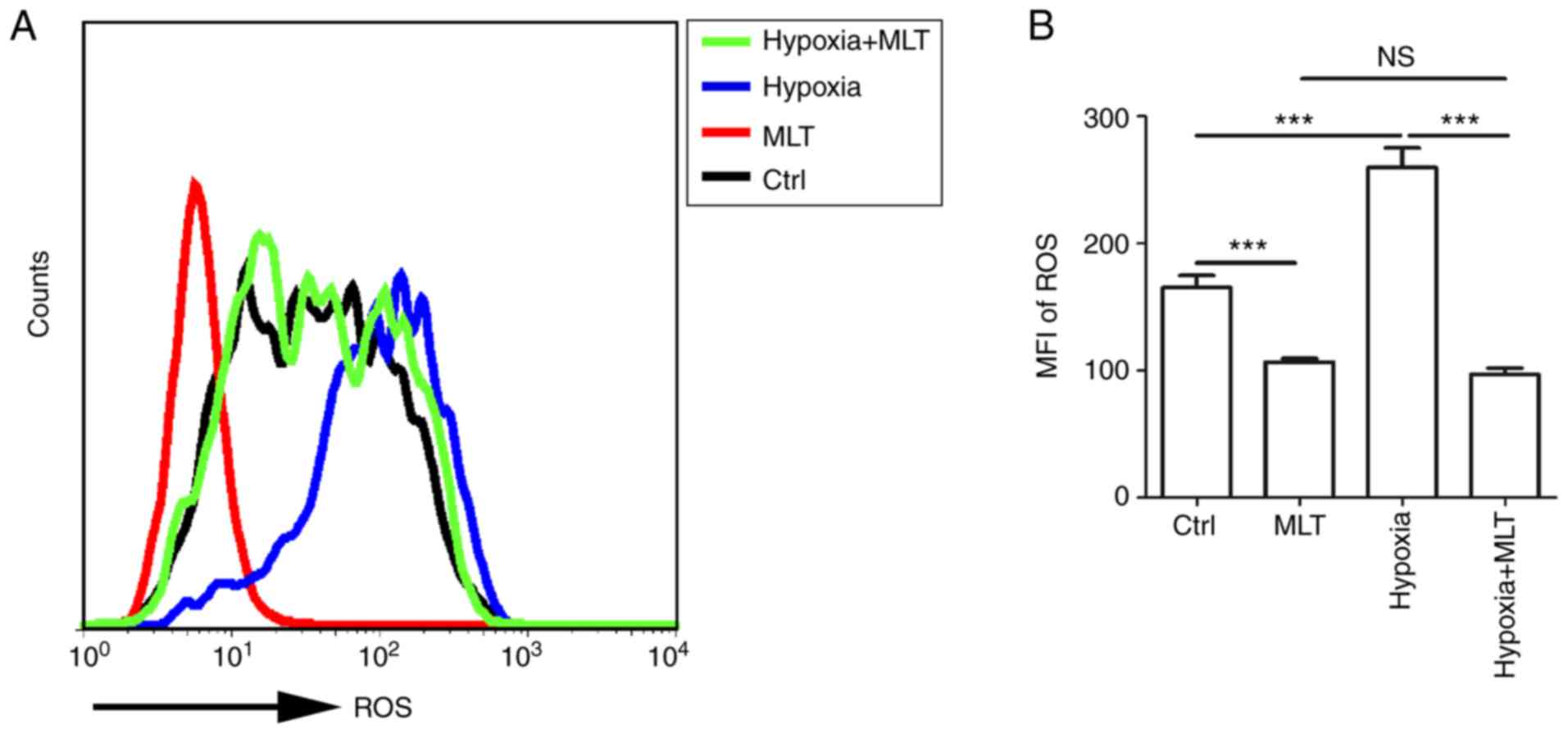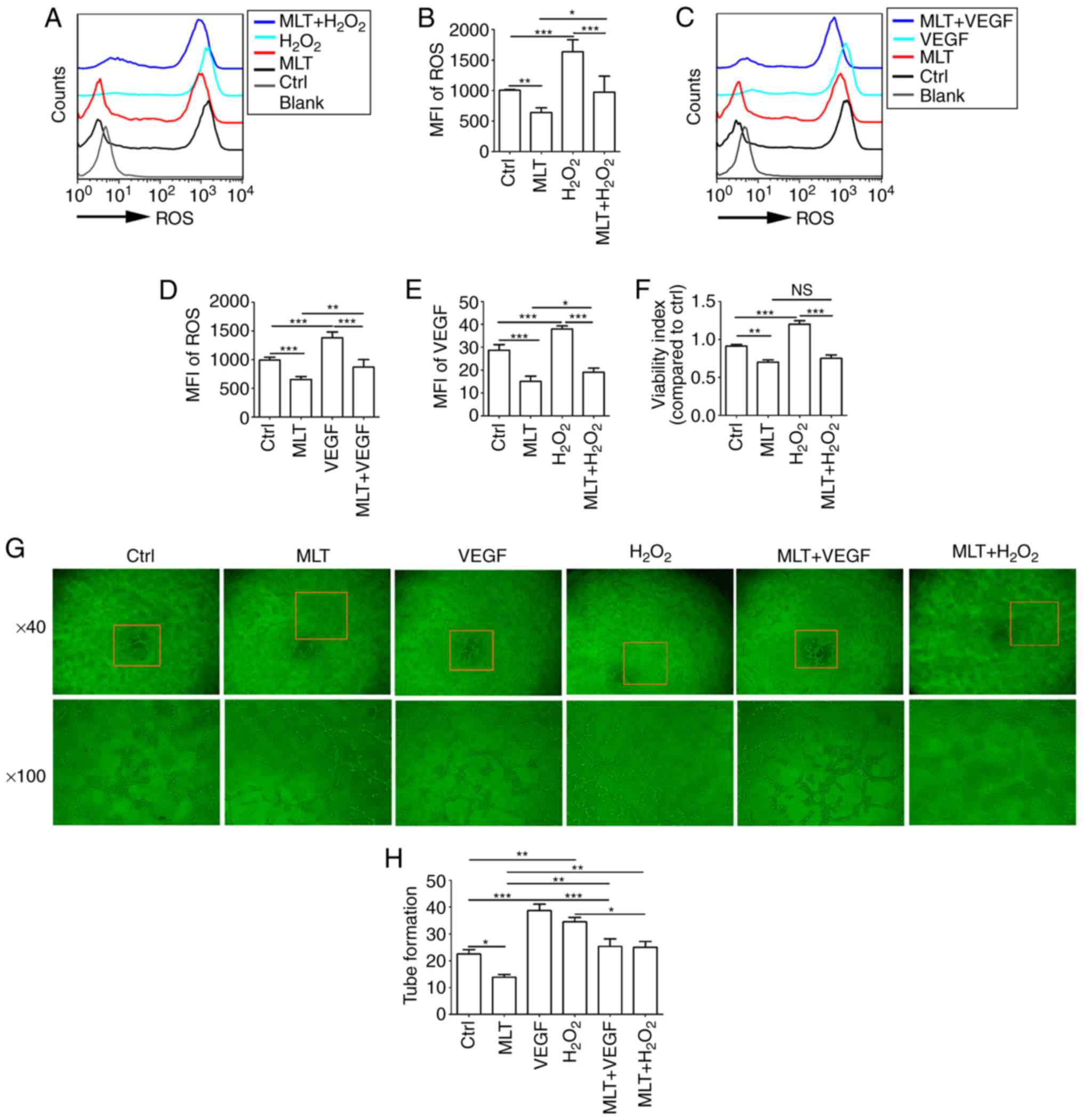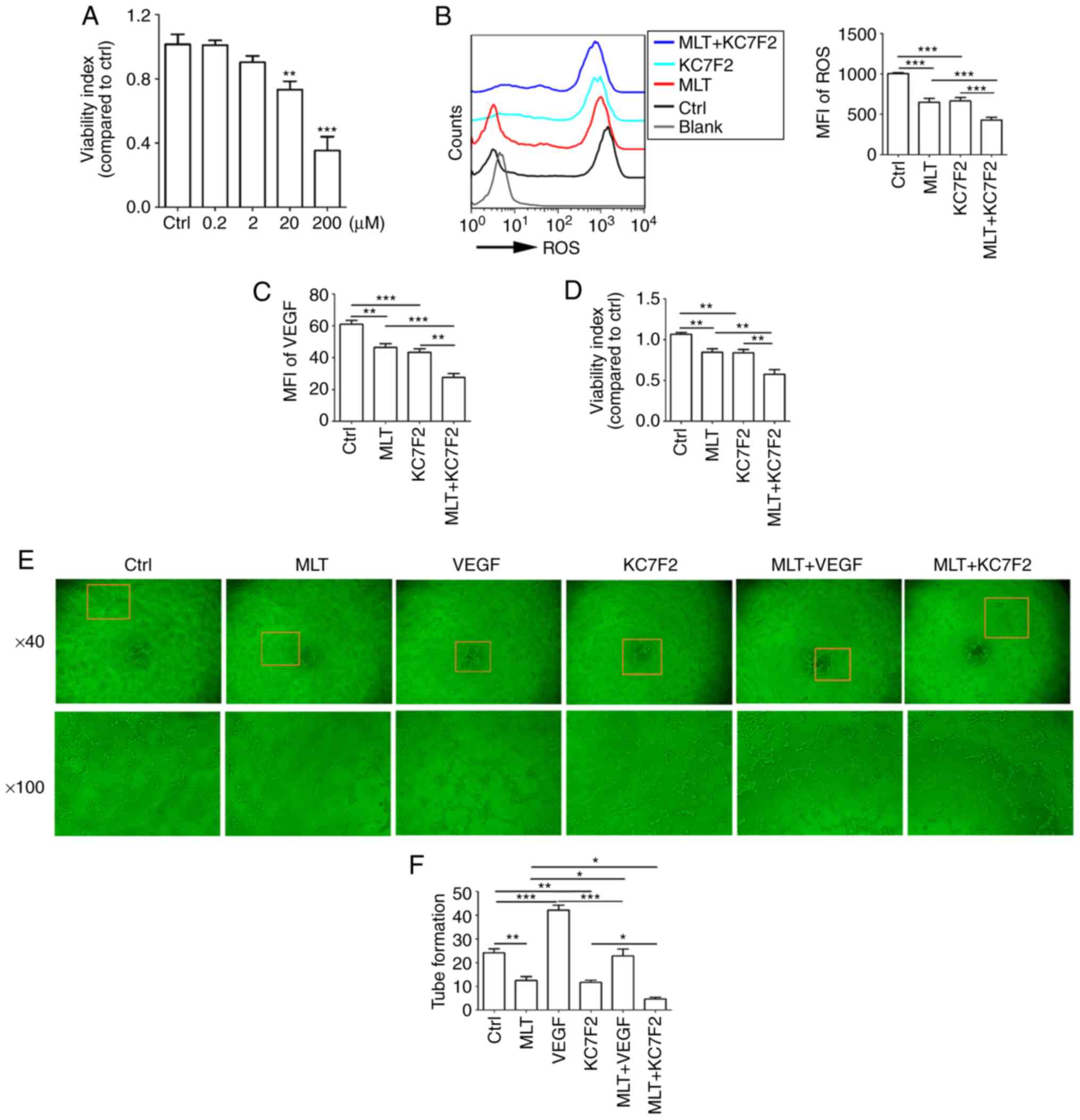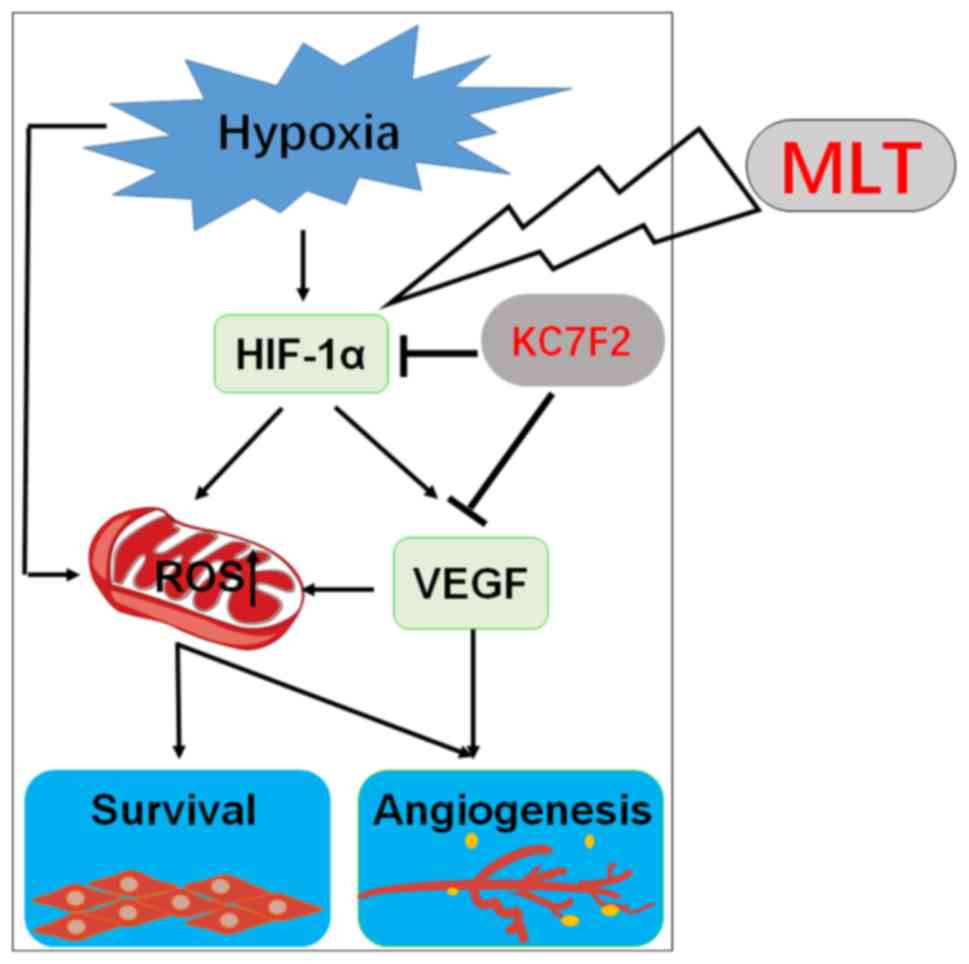|
1
|
Ushio-Fukai M and Alexander RW: Reactive
oxygen species as mediators of angiogenesis signaling-Role of
NAD(P)H oxidase. Mol Cell Biochem. 264:85–97. 2004. View Article : Google Scholar : PubMed/NCBI
|
|
2
|
Gacche RN and Meshram RJ: Targeting tumor
micro-environment for design and development of novel
anti-angiogenic agents arresting tumor growth. Prog Biophys Mol
Biol. 113:333–354. 2013. View Article : Google Scholar : PubMed/NCBI
|
|
3
|
Park JH, Yoon J and Park B: Pomolic acid
suppresses HIF1 α/VEGF-mediated angiogenesis by targeting p38-MAPK
and mTOR signaling cascades. Phytomedicine. 23:1716–1726. 2016.
View Article : Google Scholar : PubMed/NCBI
|
|
4
|
Ushio-Fukai M and Nakamura Y: Reactive
oxygen species and angiogenesis: NADPH oxidase as target for cancer
therapy. Cancer Lett. 266:37–52. 2008. View Article : Google Scholar : PubMed/NCBI
|
|
5
|
Frezzetti D, Gallo M, Maiello MR,
D’Alessio A, Esposito C, Chicchinelli N, Normanno N and De Luca A:
VEGF as a potential target in lung cancer. Expert Opin Ther
Targets. 21:959–966. 2017. View Article : Google Scholar : PubMed/NCBI
|
|
6
|
Wang Z, Dabrosin C, Yin X, Fuster MM,
Arreola A, Rathmell WK, Generali D, Nagaraju GP, El-Rayes B,
Ribatti D, et al: Broad targeting of angiogenesis for cancer
prevention and therapy. Semin Cancer Biol. 35(Suppl): S224–S243.
2015. View Article : Google Scholar : PubMed/NCBI
|
|
7
|
Lee SH, Jeong D, Han YS and Baek MJ:
Pivotal role of vascular endothelial growth factor pathway in tumor
angiogenesis. Ann Surg Treat Res. 89:1–8. 2015. View Article : Google Scholar : PubMed/NCBI
|
|
8
|
Delli Carpini J, Karam AK and Montgomery
L: Vascular endothelial growth factor and its relationship to the
prognosis and treatment of breast, ovarian, and cervical cancer.
Angiogenesis. 13:43–58. 2010. View Article : Google Scholar : PubMed/NCBI
|
|
9
|
Park WH: Effects of antioxidants and MAPK
inhibitors on cell death and reactive oxygen species levels in
H2O2-treated human pulmonary fibroblasts. Oncol Lett. 5:1633–1638.
2013. View Article : Google Scholar : PubMed/NCBI
|
|
10
|
Blaser H, Dostert C, Mak TW and Brenner D:
TNF and ROS crosstalk in inflammation. Trends Cell Biol.
26:249–261. 2016. View Article : Google Scholar : PubMed/NCBI
|
|
11
|
Redza-Dutordoir M and Averill-Bates DA:
Activation of apoptosis signalling pathways by reactive oxygen
species. Biochim Biophys Acta. 1863:2977–2992. 2016. View Article : Google Scholar : PubMed/NCBI
|
|
12
|
Tapeinos C, Larranaga A, Sarasua JR and
Pandit A: Functionalised collagen spheres reduce H2O2 mediated
apoptosis by scavenging overexpressed ROS. Nanomedicine.
14:2397–2405. 2018. View Article : Google Scholar
|
|
13
|
Chandel NS, Maltepe E, Goldwasser E,
Mathieu CE, Simon MC and Schumacker PT: Mitochondrial reactive
oxygen species trigger hypoxia-induced transcription. Proc Natl
Acad Sci USA. 95:11715–11720. 1998. View Article : Google Scholar : PubMed/NCBI
|
|
14
|
Pearlstein DP, Ali MH, Mungai PT, Hynes
KL, Gewertz BL and Schumacker PT: Role of mitochondrial oxidant
generation in endothelial cell responses to hypoxia. Arterioscler
Thromb Vasc Biol. 22:566–573. 2002. View Article : Google Scholar : PubMed/NCBI
|
|
15
|
Maraldi T, Prata C, Caliceti C, Vieceli
Dalla, Sega F, Zambonin L, Fiorentini D and Hakim G: VEGF-induced
ROS generation from NAD(P)H oxidases protects human leukemic cells
from apoptosis. Int J Oncol. 36:1581–1589. 2010.PubMed/NCBI
|
|
16
|
Colavitti R, Pani G, Bedogni B, Anzevino
R, Borrello S, Waltenberger J and Galeotti T: Reactive oxygen
species as downstream mediators of angiogenic signaling by vascular
endothelial growth factor receptor-2/KDR. J Biol Chem.
277:3101–3108. 2002. View Article : Google Scholar
|
|
17
|
Oshikawa J, Kim SJ, Furuta E, Caliceti C,
Chen GF, McKinney RD, Kuhr F, Levitan I, Fukai T and Ushio-Fukai M:
Novel role of p66Shc in ROS-dependent VEGF signaling and
angiogenesis in endothelial cells. Am J Physiol Heart Circ Physiol.
302:H724–H732. 2012. View Article : Google Scholar :
|
|
18
|
Ushio-Fukai M: VEGF signaling through
NADPH oxidase-derived ROS. Antioxid Redox Signal. 9:731–739. 2007.
View Article : Google Scholar : PubMed/NCBI
|
|
19
|
Chen S, Zhou Y, Zhou L, Guan Y, Zhang Y
and Han X: Anti-neovascularization effects of DMBT in age-related
macular degeneration by inhibition of VEGF secretion through
ROS-dependent signaling pathway. Mol Cell Biochem. 448:225–235.
2018. View Article : Google Scholar : PubMed/NCBI
|
|
20
|
Jing Y, Liu LZ, Jiang Y, Zhu Y, Guo NL,
Barnett J, Rojanasakul Y, Agani F and Jiang BH: Cadmium increases
HIF-1 and VEGF expression through ROS, ERK, and AKT signaling
pathways and induces malignant transformation of human bronchial
epithelial cells. Toxicol Sci. 125:10–19. 2012. View Article : Google Scholar
|
|
21
|
Narita T, Yin S, Gelin CF, Moreno CS,
Yepes M, Nicolaou KC and Van Meir EG: Identification of a novel
small molecule HIF-1alpha translation inhibitor. Clin Cancer Res.
15:6128–6136. 2009. View Article : Google Scholar : PubMed/NCBI
|
|
22
|
Guan G, Zhang Y, Lu Y, Liu L, Shi D, Wen
Y, Yang L, Ma Q, Liu T, Zhu X, et al: The HIF-1α/CXCR4 pathway
supports hypoxia-induced metastasis of human osteosarcoma cells.
Cancer Lett. 357:254–264. 2015. View Article : Google Scholar
|
|
23
|
Zhou H, Chen J, Lu X, Shen C, Zeng J, Chen
L and Pei Z: Melatonin protects against rotenone-induced cell
injury via inhibition of Omi and Bax-mediated autophagy in Hela
cells. J Pineal Res. 52:120–127. 2012. View Article : Google Scholar
|
|
24
|
Goradel NH, Asghari MH, Moloudizargari M,
Negahdari B, Haghi-Aminjan H and Abdollahi M: Melatonin as an
angiogenesis inhibitor to combat cancer: Mechanistic evidence.
Toxicol Appl Pharmacol. 335:56–63. 2017. View Article : Google Scholar : PubMed/NCBI
|
|
25
|
Su SC, Hsieh MJ, Yang WE, Chung WH, Reiter
RJ and Yang SF: Cancer metastasis: Mechanisms of inhibition by
melatonin. J Pineal Res. 62:e123702017. View Article : Google Scholar
|
|
26
|
Reiter RJ, Rosales-Corral SA, Tan DX,
Acuna-Castroviejo D, Qin L, Yang SF and Xu K: Melatonin, a full
service anti-cancer agent: Inhibition of initiation, progression
and metastasis. Int J Mol Sci. 18:E8432017. View Article : Google Scholar : PubMed/NCBI
|
|
27
|
Carbajo-Pescador S, Ordonez R, Benet M,
Jover R, García-Palomo A, Mauriz JL and González-Gallego J:
Inhibition of VEGF expression through blockade of Hif1alpha and
STAT3 signalling mediates the anti-angiogenic effect of melatonin
in HepG2 liver cancer cells. Br J Cancer. 109:83–91. 2013.
View Article : Google Scholar : PubMed/NCBI
|
|
28
|
Wang TH, Wu CH, Yeh CT, Su SC, Hsia SM,
Liang KH, Chen CC, Hsueh C and Chen CY: Melatonin suppresses
hepato-cellular carcinoma progression via lncRNA-CPS1-IT-mediated
HIF-1 α inactivation. Oncotarget. 8:82280–82293. 2017.PubMed/NCBI
|
|
29
|
Xu Pi H, Reiter S, Guo RJ, Zhang P, Li L,
Li Y, Cao M, Tian Z, Xie LJ, et al: SIRT3-SOD2-mROS-dependent
autophagy in cadmium-induced hepatotoxicity and salvage by
melatonin. Autophagy. 11:1037–1051. 2015. View Article : Google Scholar : PubMed/NCBI
|
|
30
|
Ma Z, Yang Y, Fan C, Han J, Wang D, Di S,
Hu W, Liu D, Li X, Reiter RJ and Yan X: Melatonin as a potential
anticarcinogen for non-small-cell lung cancer. Oncotarget.
7:46768–46784. 2016.PubMed/NCBI
|
|
31
|
Plaimee P, Weerapreeyakul N, Barusrux S
and Johns NP: Melatonin potentiates cisplatin-induced apoptosis and
cell cycle arrest in human lung adenocarcinoma cells. Cell Prolif.
48:67–77. 2015. View Article : Google Scholar : PubMed/NCBI
|
|
32
|
Proietti S, Cucina A, Reiter RJ and
Bizzarri M: Molecular mechanisms of melatonin’s inhibitory actions
on breast cancers. Cell Mol Life Sci. 70:2139–2157. 2013.
View Article : Google Scholar
|
|
33
|
Proietti S, Catizone A, Masiello MG,
Dinicola S, Fabrizi G, Minini M, Ricci G, Verna R, Reiter RJ,
Cucina A and Bizzarri M: Increase in motility and invasiveness of
MCF7 cancer cells induced by nicotine is abolished by melatonin
through inhibition of ERK phosphorylation. J Pineal Res.
64:e124672018. View Article : Google Scholar : PubMed/NCBI
|
|
34
|
Gonzalez-Gonzalez A, Gonzalez A,
Alonso-Gonzalez C, Menéndez-Menéndez J, Martínez-Campa C and Cos S:
Complementary actions of melatonin on angiogenic factors, the
angiopoietin/Tie2 axis and VEGF, in co-cultures of human
endothelial and breast cancer cells. Oncol Rep. 39:433–441.
2018.
|
|
35
|
Lee H, Lee HJ, Jung JH, Shin EA and Kim
SH: Melatonin disturbs SUMOylation-mediated crosstalk between c-Myc
and nestin via MT1 activation and promotes the sensitivity of
paclitaxel in brain cancer stem cells. J Pineal Res. 65:e124962018.
View Article : Google Scholar : PubMed/NCBI
|
|
36
|
Hill SM, Frasch T, Xiang S, Yuan L,
Duplessis T and Mao L: Molecular mechanisms of melatonin anticancer
effects. Integr Cancer Ther. 8:337–346. 2009. View Article : Google Scholar
|
|
37
|
Lai YH, Hu DN, Rosen R, Sassoon J, Chuang
LY, Wu KY and Wu WC: Hypoxia-induced vascular endothelial growth
factor secretion by retinal pigment epithelial cells is inhibited
by melatonin via decreased accumulation of hypoxia-inducible
factors-1α protein. Clin Exp Ophthalmol. 45:182–191. 2017.
View Article : Google Scholar
|
|
38
|
Park SY, Jang WJ, Yi EY, Jang JY, Jung Y,
Jeong JW and Kim YJ: Melatonin suppresses tumor angiogenesis by
inhibiting HIF-1 alpha stabilization under hypoxia. J Pineal Res.
48:178–184. 2010. View Article : Google Scholar : PubMed/NCBI
|
|
39
|
Park JW, Hwang MS, Suh SI and Baek WK:
Melatonin downregulates HIF-1 alpha expression through inhibition
of protein translation in prostate cancer cells. J Pineal Res.
46:415–421. 2009. View Article : Google Scholar : PubMed/NCBI
|
|
40
|
Cui P, Luo Z, Zhang H, Su Y, Li A, Li H,
Zhang J, Yang Z and Xiu R: Effect and mechanism of melatonin’s
action on the proliferation of human umbilical vein endothelial
cells. J Pineal Res. 41:358–362. 2006. View Article : Google Scholar : PubMed/NCBI
|
|
41
|
González A, González-González A,
Alonso-González C, Menéndez-Menéndez J, Martínez-Campa C and Cos S:
Melatonin inhibits angiogenesis in SH-SY5Y human neuroblastoma
cells by downregulation of VEGF. Oncol Rep. 37:2433–2440. 2017.
View Article : Google Scholar : PubMed/NCBI
|
|
42
|
Vriend J and Reiter RJ: Melatonin and the
von Hippel-Lindau/HIF-1 oxygen sensing mechanism: A review. Biochim
Biophys Acta. 1865:176–183. 2016.PubMed/NCBI
|
|
43
|
Livak KJ and Schmittgen TD: Analysis of
relative gene expression data using real-time quantitative PCR and
the 2(-Delta Delta C(T)) method. Methods. 25:402–408. 2001.
View Article : Google Scholar
|
|
44
|
Pan B, Zhong W, Deng Z, Lai C, Chu J, Jiao
G, Liu J and Zhou Q: Inhibition of prostate cancer growth by
solanine requires the suppression of cell cycle proteins and the
activation of ROS/P38 signaling pathway. Cancer Med. 5:3214–3222.
2016. View Article : Google Scholar : PubMed/NCBI
|
|
45
|
Alvarez-García V, González A,
Alonso-González C, Martínez-Campa C and Cos S: Antiangiogenic
effects of melatonin in endothelial cell cultures. Microvasc Res.
87:25–33. 2013. View Article : Google Scholar : PubMed/NCBI
|
|
46
|
Vijayalaxmi, Thomas CR Jr, Reiter RJ and
Herman TS: Melatonin: From basic research to cancer treatment
clinics. J Clin Oncol. 20:2575–2601. 2002. View Article : Google Scholar : PubMed/NCBI
|
|
47
|
Dai M, Cui P, Yu M, Han J, Li H and Xiu R:
Melatonin modulates the expression of VEGF and HIF-1 alpha induced
by CoCl2 in cultured cancer cells. J Pineal Res. 44:121–126. 2008.
View Article : Google Scholar : PubMed/NCBI
|
|
48
|
Colombo J, Maciel JM, Ferreira LC, Da
Silva RF and Zuccari DA: Effects of melatonin on HIF-1 α and VEGF
expression and on the invasive properties of hepatocarcinoma cells.
Oncol Lett. 12:231–237. 2016. View Article : Google Scholar : PubMed/NCBI
|
|
49
|
Zhang Y, Liu Q, Wang F, Ling EA, Liu S,
Wang L, Yang Y, Yao L, Chen X, Wang F, et al: Melatonin antagonizes
hypoxia-mediated glioblastoma cell migration and invasion via
inhibition of HIF-1 α. J Pineal Res. 55:21–130. 2013. View Article : Google Scholar
|
|
50
|
Guzy RD and Humacker PT: Oxygen sensing by
mitochondria at complex III: The paradox of increased reactive
oxygen species during hypoxia. Exp Physiol. 91:807–819. 2006.
View Article : Google Scholar : PubMed/NCBI
|
|
51
|
Scherz-Shouval R and Elazar Z: Regulation
of autophagy by ROS: Physiology and pathology. Trends Biochem Sci.
36:30–38. 2011. View Article : Google Scholar
|
|
52
|
D’Autréaux B and Toledano MB: ROS as
signalling molecules: Mechanisms that generate specificity in ROS
homeostasis. Nat Rev Mol Cell Biol. 8:813–824. 2007. View Article : Google Scholar
|
|
53
|
Zhang Y, Choksi S, Chen K, Pobezinskaya Y,
Linnoila I and Liu ZG: ROS play a critical role in the
differentiation of alternatively activated macrophages and the
occurrence of tumor-associated macrophages. Cell Res. 23:898–914.
2013. View Article : Google Scholar : PubMed/NCBI
|
|
54
|
Diebold L and Chandel NS: Mitochondrial
ROS regulation of proliferating cells. Free Radic Biol Med.
100:86–93. 2016. View Article : Google Scholar : PubMed/NCBI
|
|
55
|
Xia C, Meng Q, Lin LZ, Rojanasakul Y, Wang
XR and Jiang BH: Reactive oxygen species regulate angiogenesis and
tumor growth through vascular endothelial growth factor. Cancer
Res. 67:10823–10830. 2007. View Article : Google Scholar : PubMed/NCBI
|
|
56
|
Li Z, Xu X, Leng X, He M, Wang J, Cheng S
and Wu H: Roles of reactive oxygen species in cell signaling
pathways and immune responses to viral infections. Arch Virol.
162:603–610. 2017. View Article : Google Scholar
|
|
57
|
Morgan MJ and Liu ZG: Crosstalk of
reactive oxygen species and NF-κB signaling. Cell Res. 21:103–115.
2011. View Article : Google Scholar
|
|
58
|
Liu J, Chang F, Li F, Fu H, Wang J, Zhang
S, Zhao J and Yin D: Palmitate promotes autophagy and apoptosis
through ROS-dependent JNK and p38 MAPK. Biochem Biophys Res Commun.
463:262–267. 2015. View Article : Google Scholar : PubMed/NCBI
|
|
59
|
Prasad S, Gupta SC and Tyagi AK: Reactive
oxygen species (ROS) and cancer: Role of antioxidative
nutraceuticals. Cancer Lett. 387:95–105. 2017. View Article : Google Scholar
|
|
60
|
Wang RX, Liu H, Xu L, Zhang H and Zhou RX:
Melatonin downregulates nuclear receptor RZR/RORγ expression
causing growth-inhibitory and anti-angiogenesis activity in human
gastric cancer cells in vitro an in vivo. Oncol Lett. 12:897–903.
2016. View Article : Google Scholar : PubMed/NCBI
|
|
61
|
You BR, Shin HR and Park WH: PX-12
inhibits the growth of A549 lung cancer cells via G2/M phase arrest
and ROS-dependent apoptosis. Int J Oncol. 44:301–308. 2014.
View Article : Google Scholar
|
|
62
|
Bauer G: Central signaling elements of
intercellular reactive oxygen/nitrogen species-dependent induction
of apoptosis in malignant cells. Anticancer Res. 37:499–513. 2017.
View Article : Google Scholar : PubMed/NCBI
|















